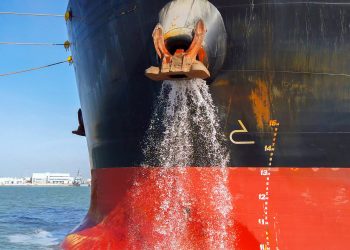The Paris MoU published results of its Concentrated Inspection Campaign (CIC) on MARPOL Annex VI between 1 September and 30 November 2018. The overall detention rate was 0.2% for CIC-topic deficiency rate (average number of deficiencies reported per inspection), which is a satisfactory result, Paris MoU said.
The objective of the CIC was to provide indications as to the industry’s level of compliance with specific aspects of MARPOL Annex VI regardless of ship type.
The analysis is done on the results of the CIC questionnaire and on the data in the inspections database.

Key figures
- The results show a number of 4217 inspections with the CIC questionnaire.
- 283 of those inspections have been done without questionnaire due to earlier inspections and EU inspection requirements that exempt ROPAX type of ships from Paris MoU PSC inspection.
- In general the percentage of detentions due to the CIC, did not lead to a higher percentage of the average detention percentage.
However, it should be noted that only in 7 cases out of 230 answers with a “NO” where a detention could be considered, the deficiency was considered serious enough to detain the ship.
- Based on those figures it shows that the Fuel change-over procedure was the most recorded as ground for detention (4) followed by Ship Energy Efficiency Management Plan, Bunker delivery notes, Incinerator, Ozone-depleting substances and sulphur content of fuel (1).
- Looking at the number of inspections with deficiencies, the Bunker delivery notes (112) followed by Fuel Change-over Procedure (80) are recorded most by numbers. It should however be noted, that the number of inspections with deficiencies on ozone-depleting substances record book (Q6) shows a relative high number of deficiencies.
- Responses to Question 10, which asked whether the ship keep on board a Ship Energy Efficiency Management Plan (SEEMP), reported the most favourable results – 99.5% responded yes. This was closely followed with Question 2, which asked whether the ships bunker delivery notes indicate that fuel oils delivered and used on board is not exceeding the maximum allowed sulphur content, – 99.3% responded yes.
- The least favourable results were reported for Question 4, which asked whether an alternative arrangement, (e.g. scrubber) was installed on board, according to regulation 4.1, was approved by the flag State – 62.2% responded no.
- This was followed by Question 6, which asked whether the ships which have rechargeable systems containing ozone-depleting substances (refer to the supplement to the IAPP Certificate, item 2.1), have the ozone-depleting substances record book maintained – 12.6% responded no.
- Question 4 which address the CIC focus on the approval of alternative arrangements(if any) hold the highest “n/a” response (92.8%).
- Of the 140 ships detained during the CIC, 7 were related to the CIC topic representing 5% of total detentions and 0.17% of all inspections.
- The overall detention rate as percentage of inspections was 3.3%.
- The overall CIC-topic detention rate as related to percentage of inspections was 0.2% (9 cases).
- By ship age, younger ships(<5 years) and ships between 26-35 years had the lowest detention rate for CIC-topic detentions (0%) while the highest rate peaked for ships aged 16-20 years (0.6%).
Number of inspected ships and detentions per ship type
With respect to CIC-topic related detentions:
- Commercial yacht ships had the highest CIC-topic related detention rate as per inspection (3.1%), followed by
- Ro-Ro Cargo (0.6%),
- Oil tanker (0.3%) and
- general cargo/multipurpose and bulk carrier (2.2%).
- A number of ship types had zero CIC-topic related detentions.
Inspections and detentions per Flag State
- Ships from 86 flag states were inspected during the CIC.
- 80 flag states (93%) did not have any CIC-topic related detentions.
- Of those that did, the highest number of ships detained were Antigua & Barbuda (2), followed by the Malta (1), Panama (1), Republic of Moldova (1), Saint Vincent and the Grenadines (1), and Cyprus (1).
- The highest percentage of ships detained was however followed by The Republic of Moldova (3.6%), Saint Vincent and the Grenadines (2.4%), Antigua & Barbuda (1.2%), Cyprus (0.8%), Malta (0.3%), and Panama (0.2%).
- The worst performance on CIC-topic detentions percentage vice aligns well in the case of The Republic of Moldova but not in the case of the others which hold a mix of white and grey list statuses.
Recommendations
- In relation to the deficiency “Bunker delivery notes” and the “fuel change-over procedure” which had the largest number of deficiencies, the industry should take note and care to ensure that the BDN is kept on board for minimum 3 years and has the minimum required information and that ships with two different marine-fuels regarding to sulphur content, that the fuel change-over procedure is on board and used within the scope of the convention.
- Industry should endeavour to have focus on the sulphur content of the used marine fuels in SECA’s and also in the light of the global requirement of 0.5% sulphur content of fuel used from 1 January 2020.
Explore more herebelow:
































































